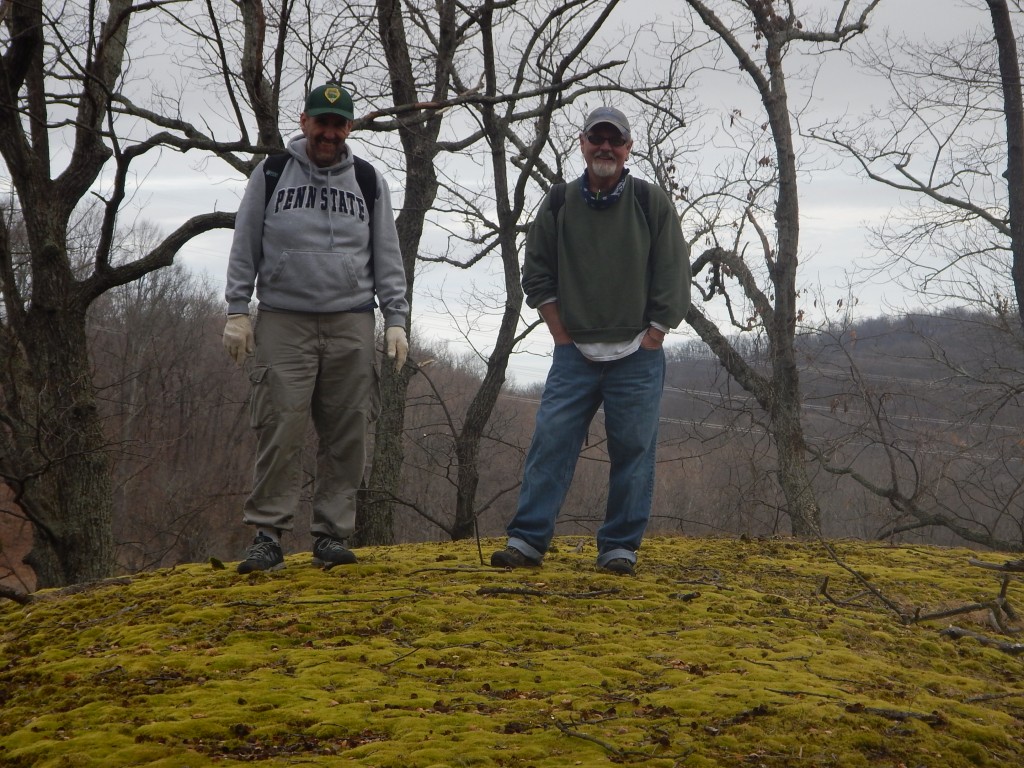Penn State University Research at Radnor Lake State Natural Area

This past week (March 7th thru March 12th, 2015) Dr. Robert Loeb from the DuBois Campus of the Pennsylvania State returned to Radnor Lake State Natural Area to expand his research on endangered plant species and initiate a new research collaboration on the effects of past agricultural practices on the environments of the Natural Area.
The endangered plant research was focused on two species recently discovered in Radnor Lake – Wild Dill and Deam’s Copperleaf. The Wild Dill sites showed great promise for growth in the Wild Dill populations because the invasive species bush honeysuckle has not recovered from the removal treatments performed last year.
Following up on the Deam’s Copperleaf survey work done with Roger McCoy, who is the Director of Natural Areas for Tennessee, Dr. Loeb and SIR Will Peters, inventoried the distribution of plants in the research plots in the Hideaway Tract, which also was recently acquired by the Friends of Radnor Lake, The Land Trust for Tennessee and the State of Tennessee.
The endangered plants research is a multi-year project that is expected to reveal important new information concerning the ecology of the two species that will help to maintain viable populations of the endangered species in the Natural Area.
In addition, Dr. Loeb collaborated with Professors Doug Heffington of Middle Tennessee State University, and Lisa Mayo of Motlow State Community College who joined Dr. Loeb to provide their expertise in cultural geography and geology, respectively.
Understanding how past farm practices influenced the development of modern forests is not just a matter of identifying the current trees. To clearly understand how the effects of agriculture and animal husbandry influenced the forests.The three scientists look forward to gathering a great deal of information and collaborating on the investigations, which they expect will reveal valuable knowledge concerning the factors influencing the origins of forests in Radnor Lake State Natural Area.
Park management and the ranger staff would like to thank Dr. Loeb for his time and assistance this past week in our efforts in understanding and interpreting these significant resources within Radnor Lake State Natural Area. We look forward to working with him for years to come.
We appreciate Dr. Loeb and Dr. Heffington for their time this week during their respective spring breaks to come to Radnor to conduct this research with the ranger staff.
Special thanks to Friends for Radnor Lake for funding assistance for our research this past week!
The endangered plant research was focused on two species recently discovered in Radnor Lake – Wild Dill and Deam’s Copperleaf. The Wild Dill sites showed great promise for growth in the Wild Dill populations because the invasive species bush honeysuckle has not recovered from the removal treatments performed last year.
Following up on the Deam’s Copperleaf survey work done with Roger McCoy, who is the Director of Natural Areas for Tennessee, Dr. Loeb and SIR Will Peters, inventoried the distribution of plants in the research plots in the Hideaway Tract, which also was recently acquired by the Friends of Radnor Lake, The Land Trust for Tennessee and the State of Tennessee.
The endangered plants research is a multi-year project that is expected to reveal important new information concerning the ecology of the two species that will help to maintain viable populations of the endangered species in the Natural Area.
In addition, Dr. Loeb collaborated with Professors Doug Heffington of Middle Tennessee State University, and Lisa Mayo of Motlow State Community College who joined Dr. Loeb to provide their expertise in cultural geography and geology, respectively.
Understanding how past farm practices influenced the development of modern forests is not just a matter of identifying the current trees. To clearly understand how the effects of agriculture and animal husbandry influenced the forests.The three scientists look forward to gathering a great deal of information and collaborating on the investigations, which they expect will reveal valuable knowledge concerning the factors influencing the origins of forests in Radnor Lake State Natural Area.
Park management and the ranger staff would like to thank Dr. Loeb for his time and assistance this past week in our efforts in understanding and interpreting these significant resources within Radnor Lake State Natural Area. We look forward to working with him for years to come.
We appreciate Dr. Loeb and Dr. Heffington for their time this week during their respective spring breaks to come to Radnor to conduct this research with the ranger staff.
Special thanks to Friends for Radnor Lake for funding assistance for our research this past week!



